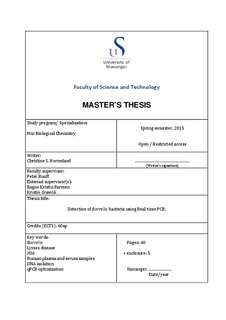| dc.contributor.author | Horneland, Christine | |
| dc.date.accessioned | 2015-09-16T13:52:54Z | |
| dc.date.available | 2015-09-16T13:52:54Z | |
| dc.date.issued | 2015-06-15 | |
| dc.identifier.uri | http://hdl.handle.net/11250/300337 | |
| dc.description | Master's thesis in Biological chemistry | nb_NO |
| dc.description.abstract | Lymes disease (LD) caused by bacteria in the Borrelia genus is the most commonly known vector borne disease on the northern hemisphere. There are at least 10 human pathogenic Borrelia species known to date, five of which have been identified in Norwegian ticks. Diagnosis of LD is routinely done by serological tests such as ELISA. However, this method of diagnosis is not well suited to distinguish between a wide range of LD symptoms and the disease causing bacterial species. Serological tests are dependent on an immune response, which may not always occur. Furthermore the immune response is a slow process, typically occurring 6 weeks after infection. A direct method of detection based on DNA typing would potentially allow earlier detection of bacterial infection as well as identify the actual disease causing Borrelia species.
Currently there is no direct testing method commercially available, and the Borrelia bacteria have proven difficult to work with. In the scientific community, there is controversy as to which is the most optimal sample material for bacterial DNA isolation, as well as which method of detection is the most suitable to apply. In this thesis the development of a direct detection method for the Borrelia bacteria by the hbb gene for a histone-like protein in human plasma and serum samples with real-time PCR (qPCR) was attempted.
Blood samples from medical patients who had tested positive for LD with ELISA antibody detection was used for isolation of Borrelia bacteria. The hbb-gene used for primer and probe design is highly conserved between species of Borrelia bacteria. A sufficient extraction method and qPCR optimisation was considered essential for Borrelia detection.
Borrelia was not detected in any of the samples tested. Both the DNA extraction and the qPCR assay applied for the testing needs to be further optimised. If we had succeeded in isolating bacterial DNA from blood samples, we would have proceeded to develop a melting curve qPCR analysis to distinguish between different strains of the disease causing bacteria. | nb_NO |
| dc.language.iso | eng | nb_NO |
| dc.publisher | University of Stavanger, Norway | nb_NO |
| dc.relation.ispartofseries | Masteroppgave/UIS-TN-IMN/2015; | |
| dc.rights | Navngivelse 3.0 Norge | * |
| dc.rights.uri | http://creativecommons.org/licenses/by/3.0/no/ | * |
| dc.subject | Lyme disease | nb_NO |
| dc.subject | Hbb | nb_NO |
| dc.subject | DNA isolation | nb_NO |
| dc.subject | qPCR optimization | nb_NO |
| dc.subject | biologisk kjemi | nb_NO |
| dc.subject | Borrelia | nb_NO |
| dc.title | Detection of Borrelia bacteria using real-time PCR | nb_NO |
| dc.type | Master thesis | nb_NO |
| dc.subject.nsi | VDP::Mathematics and natural science: 400::Basic biosciences: 470::Biochemistry: 476 | nb_NO |

